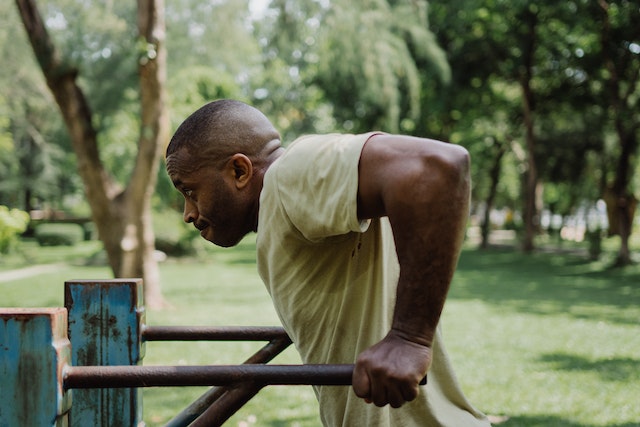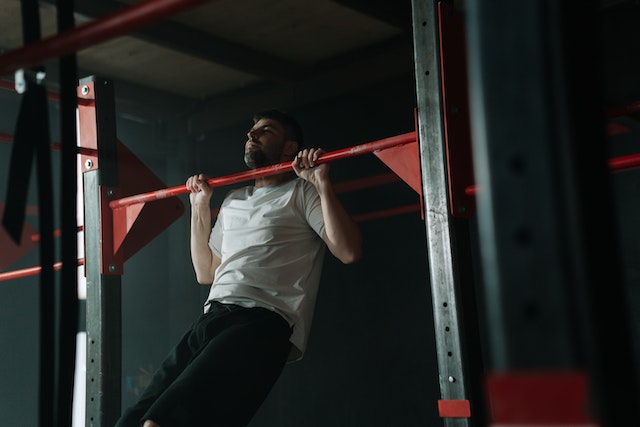Are you on a quest to conquer the calisthenics world, aiming to achieve awe-inspiring feats of strength and athleticism? If so, you’ve likely come across the classic exercises of push-ups and pull-ups. But here’s the million-dollar question: can mastering push-ups actually help you soar to new heights with your pull-ups?
In this gripping article, we unravel the longstanding debate surrounding the relationship between push-ups and pull-ups. We’ll delve into the mechanics of these powerhouse exercises, explore the muscle groups they target, and discover how they might complement each other in your calisthenics journey. So, buckle up, fitness enthusiasts, as we embark on a thrilling adventure to unlock the secrets behind these foundational movements and unveil the potential synergy they hold for your ultimate calisthenics triumph!
Understanding the Mechanics
To truly grasp the impact of push-ups and pull-ups on your calisthenics prowess, it’s essential to delve into the mechanics of these two fundamental exercises.
Breakdown of push-ups and pull-ups
Push-ups: The timeless push-up is a compound exercise that primarily targets the chest, shoulders, and triceps. As you lower and raise your body using only your upper extremities, the pectoral muscles work diligently to stabilize and power the movement. Simultaneously, your deltoids and triceps engage to assist in maintaining proper form and generating pushing force.
Pull-ups: On the other hand, the mighty pull-up challenges the muscles of your upper body in a different manner. This bodyweight marvel predominantly targets the lats, rhomboids, and biceps. As you hang from a bar and pull yourself up, your latissimus dorsi muscles come to life, working diligently to pull your bodyweight towards the bar. The rhomboids, located between the shoulder blades, assist in shoulder retraction, while the biceps play a vital role in bending your elbows during the upward phase of the movement.
Identifying the overlapping muscles
Interestingly, despite their apparent differences, push-ups and pull-ups share some common ground when it comes to the muscles they engage. Both exercises demand significant effort from the core muscles, which play a pivotal role in stabilizing the torso and maintaining proper alignment.
Additionally, the trapezius, a large muscle spanning from the neck to the upper back, is engaged in both push-ups and pull-ups to varying degrees. While it supports the shoulders during push-ups, it is also crucial for scapular elevation during the upward phase of pull-ups.
Understanding these shared muscle groups allows us to explore the potential synergy between push-ups and pull-ups. As we progress further, we’ll investigate how building strength in these overlapping muscles could unlock new levels of performance and bring us closer to conquering the calisthenics world!
Push Ups and Upper Body Strength
Push-ups, often considered a foundational exercise, are a powerhouse for building upper body strength. Let’s dive into the benefits they offer and how they lay the groundwork for conquering the elusive pull-up.
Benefits of push-ups for upper body development
- Sculpting the chest, shoulders, and triceps – the push-up trifecta! The primary movers in push-ups are the pectoral muscles (chest), anterior deltoids (front shoulders), and triceps. As you push your body off the ground, these muscles work in harmony to create a balanced and robust upper body foundation.
- Strengthening the core and improving stability: Beyond the obvious upper body focus, push-ups also activate the core muscles. As you maintain a straight plank position during the exercise, your abdominal muscles contract to stabilize your spine, improving overall balance and control.
Linking push-up strength to pull-up potential
Building upper body strength through push-ups can have a profound impact on your pull-up performance. The muscles engaged in both exercises overlap to a significant extent, creating a pathway for skill transfer and muscle development.
By mastering push-ups, you enhance your ability to stabilize and control your upper body, a crucial skill in performing pull-ups. The strengthened pectoral muscles, anterior deltoids, and triceps contribute to the pulling motion required in pull-ups, providing a well-rounded approach to upper body strength.
The Pull-Up Predicament
Ah, the revered pull-up – a badge of honor among calisthenics enthusiasts. But don’t be fooled by its allure; the pull-up can be a formidable challenge for many aspiring athletes. Let’s delve into the intricacies of this exercise and understand the hurdles it presents.
Deconstructing the pull-up movement
The pull-up is a compound exercise that primarily targets the muscles in your upper body, specifically the latissimus dorsi (lats), the largest muscles of the back. As you hang from a bar and pull your body upward, the lats kick into action, working hard to bring your chin above the bar. Additionally, the muscles of the upper back, including the rhomboids and trapezius, assist in shoulder retraction and maintaining proper posture throughout the movement.
Performing a pull-up also calls upon the biceps to flex your elbows, making it a fantastic upper body strength developer.
Addressing common pull-up struggles
While the pull-up may seem straightforward, mastering it often proves to be a challenging endeavor, especially for beginners. Common struggles include:
- Limited upper body strength: Many find that their upper body lacks the required strength to lift their bodyweight repeatedly. This is especially true for those new to calisthenics or strength training.
- Muscle imbalances: Pull-ups demand a balanced distribution of strength across various muscle groups. Muscle imbalances, where certain muscles overpower others, can hinder progress and even lead to injuries.
- Technical difficulty: Achieving proper pull-up form requires proper technique and body positioning. Without it, the exercise becomes less effective and increases the risk of injury.
- Mental barriers: As with any challenging exercise, self-doubt and mental barriers can hold you back from reaching your full potential in pull-ups.
Understanding these hurdles is essential, as it allows us to approach pull-up training with a well-informed strategy. Fear not, for in the next section, we will explore how push-ups can come to your rescue, helping you overcome these obstacles and reach the pinnacle of calisthenics achievement – the elusive, empowering, and exhilarating pull-up! So, let’s keep our spirits high and get ready to conquer the pull-up predicament once and for all.
Push-Ups as a Stepping Stone
If you’ve ever gazed longingly at the pull-up bar, dreaming of conquering the elusive pull-up, push-ups may just be the secret stepping stone you’ve been seeking. As we bridge the gap between these two iconic exercises, let’s explore how push-ups can pave the way to pull-up mastery.
Incorporating push-ups in pull-up training
Push-ups are more than just an upper body workout; they serve as an excellent foundation for building functional strength. By integrating push-ups into your calisthenics routine, you set the stage for a well-rounded approach to upper body conditioning.
- Progressive variations: Push-ups come in various forms, from traditional to advanced variations like diamond push-ups, decline push-ups, and planche push-ups. Progressing through these variations challenges your muscles in unique ways, preparing you for the dynamic requirements of pull-ups.
- Muscle activation: As you perform push-ups, the muscles involved in both push-ups and pull-ups are activated, reinforcing their connection and potential for skill transfer. Strengthening your chest, shoulders, triceps, and core through push-ups directly supports the motion and stability needed for pull-up success.
Targeted muscles and their impact on pull-ups
Delving deeper into the relationship between push-ups and pull-ups, it becomes evident that specific push-up variations can directly benefit your pull-up performance.
- Building a solid foundation: Mastering basic push-ups establishes a strong foundation for more advanced exercises, allowing you to gradually increase your upper body strength and control.
- Strengthening key pull-up muscles: Push-up variations like close-grip push-ups emphasize the engagement of your biceps, while pseudo planche push-ups target the front deltoids and rhomboids. These targeted muscle groups play vital roles in pulling your body upward during pull-ups, bridging the gap between the two movements.
By blending push-ups into your pull-up training, you create a cohesive and comprehensive approach to upper body development. Remember, progress takes time, so be patient and celebrate each step forward. As we continue our journey towards calisthenics excellence, it’s time to harness the power of push-ups and witness their transformative effect on your pull-up potential. The pull-up bar awaits, and you’re now equipped with the tools to rise to new heights!
Conclusion
In the thrilling quest to uncover the truth behind the interplay of push-ups and pull-ups in calisthenics, we’ve discovered a treasure trove of insights. Push-ups, with their ability to sculpt the chest, shoulders, triceps, and core, serve as the building blocks for upper body strength and stability.
As we unraveled the enigma of the pull-up, we encountered the challenges that make it a true test of calisthenics prowess. Limited upper body strength, muscle imbalances, technical difficulties, and mental barriers form the hurdles to conquer.
Yet, fear not, for armed with the knowledge that push-ups can be a stepping stone to pull-up mastery, we’ve charted a path forward. By incorporating progressive push-up variations and targeting specific muscle groups, we unlock the potential for skill transfer and enhanced pull-up performance.
In the world of calisthenics, progress is the journey’s essence. Embrace the journey, celebrating every milestone and learning from each setback. Push-ups and pull-ups, these iconic exercises, beckon you to explore their boundless possibilities.





